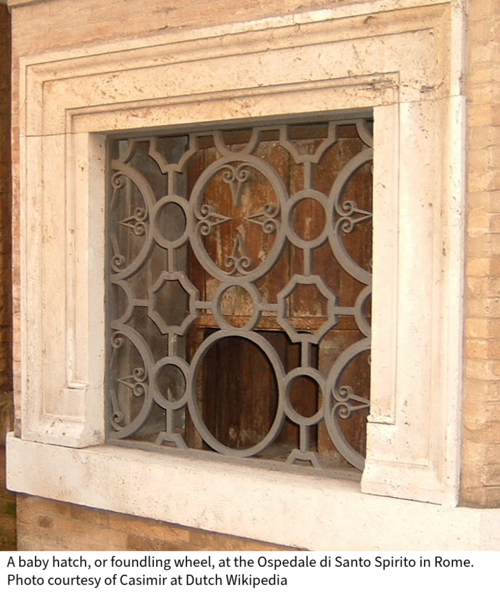Yale Bioethicist Warns: Baby Boxes May Harm Mothers and Infants Despite Good Intentions

In the Middle Ages, churches in Europe often had a hatch, known as a foundling wheel, installed in an exterior wall to facilitate the anonymous relinquishment of infants. A parent facing difficult social or economic circumstances could place a baby inside, turn the revolving cylinder, and ring a bell to alert someone of the child’s presence.
The practice declined in the 1800s. But in the United States today, a modern version of the foundling wheel, known as a baby box, has gained popularity despite existing methods that either help struggling parents receive resources to keep their children or allow them to surrender an infant face-to-face. In-person care opens the door for options counseling, health care for the mother and child, and some limited legal protections.
“Many groups and individuals are passionate about providing safe solutions for our most vulnerable infants,” said Lori Bruce, associate director of Yale’s Interdisciplinary Center for Bioethics. “And so, we do share the same policy goals. However, those who advocate for baby boxes are unaware of the considerable ethical, legal, and social harms and unintended consequences that boxes add to the policy environment.”
Among other initiatives, the center, supported by the Institution for Social and Policy Studies, provides guidance for legislators and policymakers around ethical issues. Bruce has studied infant abandonment laws for 10 years, recently working with policymakers and providing testimony for proposed laws in Alaska, Illinois, Texas, New Mexico, North Carolina, and Connecticut. She has mapped nearly 350 such devices in use across the country, often installed in fire stations.
Modern infant abandonment boxes possess alarms, video monitors, and temperature controls critical to keeping an infant alive. However, the U.S. Food and Drug Administration does not currently consider the most popular box, sold by a single manufacturer, to qualify as a medical device. They are therefore unregulated, and experts say they pose risks to the infant’s survival.
As Bruce meets with decision-makers, she explains how traditional safe haven surrenders usually require individuals to hand over infants directly to medical personnel, such as nurses or EMS workers. But infant drop boxes remove the need for any personal interaction.
“This lack of contact significantly limits access to immediate medical care and emotional support,” Bruce said. “This absence of professional engagement is especially troubling, as research has shown that those most likely to use anonymous options are often most in need of crisis counseling and unaware of other options they might prefer — such as ways to help them keep their child.”
In addition, Bruce said these parents also often lack access to prenatal care and medical support during delivery, and eliminating face-to-face contact makes it much harder to link them to resources.
In an open letter to the U.S. Department of Health and Human Services last year, co-signed by nearly 100 medical professionals and state officials, Bruce outlined potential harms and unintended consequences related to infant abandonment boxes.
For example, the devices can be installed in a location without the constant presence of onsite staff, endangering the health of a vulnerable infant and possibly delaying discovery; the anonymity prevents any transfer of the baby’s medical history, compromising their health outcomes; the device signage and marketing decreases the ability for at-risk families to understand all of their options, leading to unnecessary and permanent family separation; the devices deny the children’s rights to know their identities; they may be in violation of the Indian Child Welfare Act, which aims to protect “the unique value of Indian culture” by placing a Native American child in a family within their tribe; and the devices can potentially conceal crimes, such as rape, incest, or human trafficking.
Bruce advocates for policies to allow for increased support and confidentiality, which she calls “supported birth.” Such policies would allow someone to give birth in a hospital or birthing center, with their admission safeguarded to protect them from potential intimate partner violence or social shame. Pregnant and postpartum women in the United States are more likely to be murdered than to die from medical complications.
“Under such policies, someone giving birth and who needs an extra layer of confidentiality during their hospital admission will receive medically supervised labor and delivery as well as crisis counseling and informed consent to understand their options,” Bruce said. “People who are overwhelmed might not know which resources they can tap and can be talked into putting a baby up for adoption that they might otherwise have been able to keep.”
Bruce cited the adoption scholar Gretchen Sisson, whose interviews chronicle women who have given their children up for adoption and the emotional struggles that can last the rest of their lives.
“The vast majority of parents do not want to give up their children,” Bruce said. “At the same time, we are trying to prevent these unattended out-of-hospital births, which can lead to hemorrhage, trauma, depression, regret, and unrelenting life-long grief.”
Bruce said that a supported birth policy recently introduced in Japan facilitated nearly 40% of individuals utilizing confidential birth to keep their baby.
“That’s a phenomenal number,” Bruce said. “In most of Japan, women who have children outside of marriage may face enormous social barriers. It can be hard for them to get an apartment or keep their job given considerable social stigma towards families without fathers. Supported birth helped these women see a way forward for their family.”
With Bruce’s guidance, some states have declined to pass what she considers to be well-intended but potentially harmful infant abandonment bills. Others have added her harm reduction guidance to their bills, such as the posting of options and legal implications for parents near the boxes. But she and other experts advocate for a more holistic and data-based approach to crisis pregnancies that also considers the needs and values of the parent instead of solely focusing on the perceived best interests of the infant.
Bruce’s work recently led to the first confidential birth bill within the United States, with support from legislators and other stakeholders to resurrect it next legislative session to help hospitals codify support for this vulnerable population.
Although the national birth rate has been dropping, birth rates are rising in 13 states. And Bruce said families are grappling with recent and looming state and federal actions that further exacerbate harsh economic conditions, which often lead to relinquishment.
“We ought to look back in history,” Bruce said, noting how foundling museums in Europe have tens of thousands of tokens on display, which illustrate the profound loss felt by relinquishing parents. These tokens are unique identifying objects that parents left with their children in the hopes of later describing them to reclaim their children.
“Some tokens were small pieces of hand-stitched embroidery, a prayer card, or a coin cut in half,” Bruce said. “I don’t want to someday have such a collection here in the United States.”